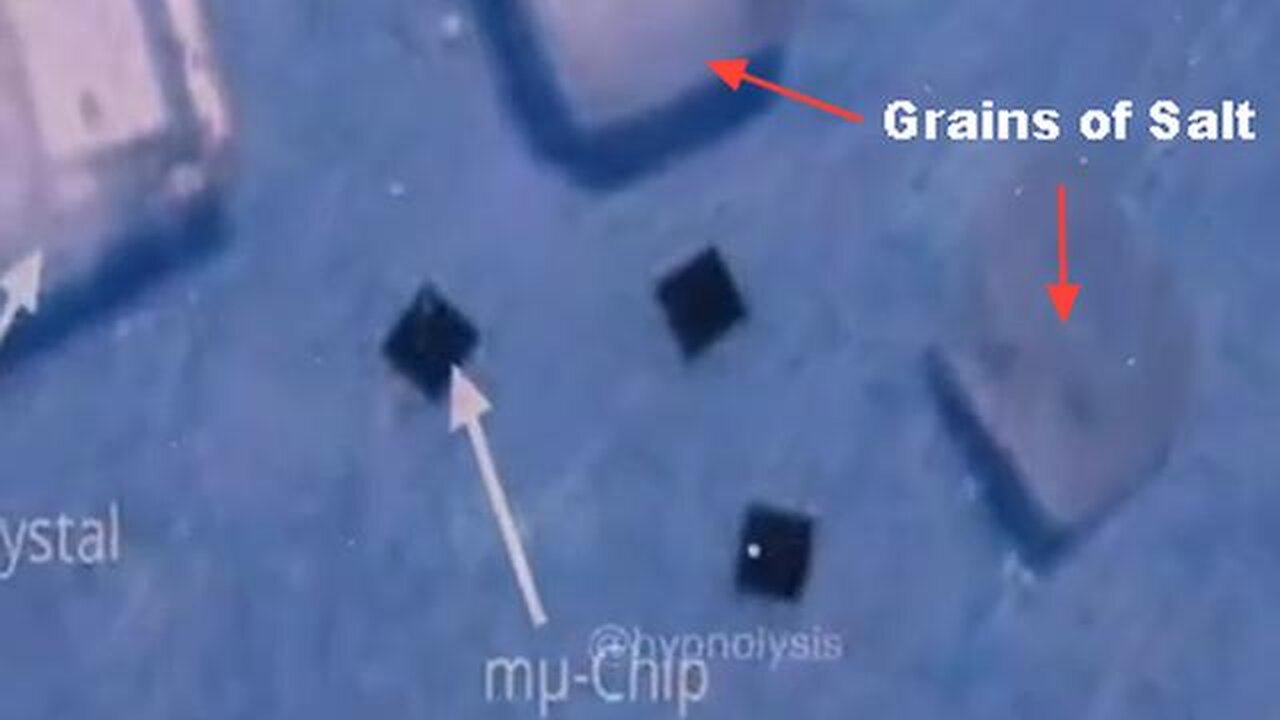Premium Only Content

DARPA Smart Dust Powered by Wireless Radio Frequencies. Ingestible, Inhailable Nano Sensor
DARPA Smart Dust Powered by Wireless Radio Frequencies. Ingestible, Inhailable Nano Sensor Transmitter - Receiver
-
THIS TECHNOLOGY IS OVER 10 YEARS OLD
-
THINK ABOUT WHAT THEY CAN DO NOW?
-
FAIR USE FOR EDUCATIONAL PURPOSES
-
Mirrored From:
https://www.bitchute.com/channel/piratepete/
*
World's smallest and thinnest 0.15 x 0.15 mm, 7.5µm thick RFID IC chip Enhanced productivity enabled by 1/4 surface area, 1/8th thickness -
-
https://www.hitachi.com/New/cnews/060206.html
-
February 6, 2006
Hattachi
-
The µ-Chip is one of the world's smallest contactless IC chips which uses an external antenna to receive radio waves (2.45 GHz microwaves), and transforms it to energy to wirelessly transmit a 128 bit (1038) unique ID number. As the data is written during the fabrication process using ROM (Read-Only-Memory), it is impossible to rewrite the data and thus provides a high level of authenticity. The admission ticket system for the 2005 World Exposition, which had approximately 22,050,000 visitors, employed the µ-Chip, has a performance record of no incidence of confirmed forgery and 0.001% incidence of ticket recognition error. By taking advantage of the merits of compactness, high authenticity and contactless communication, and combining it with Internet technology, the µ-Chip may be utilized in a broad range of applications such as security, transportation, amusement, traceability and logistics.
*
Graphene Based Nano-Antennas May Enable Cooperating Smart Dust Swarms 2014
-
https://newatlas.com/graphene-nano-antennas-smart-dust-swarm/30373/
*
Amazing Polly: Intrabody Biomolecular Communications for the Internet of Bio-NanoThings
-
While we were sleeping this is what the telecommunications and satellite people were doing. IntraBioNets Control / communication between the human body and satellites. And this was written pre 2020 https://ianakyildiz.com/projects/
-
Heterogeneous Intrabody Biomolecular Communications for the Internet of Bio-NanoThings
-
The goal of the IntraBioNets project (Foundational Models of Heterogeneous Intrabody Biomolecular Communication Network Links for the Internet of Bio-NanoThings) is to address fundamental challenges in the development of a self-sustainable and biocompatible network infrastructure to interconnect the next- generation nanotechnology and synthetic-biology-enabled electrical and biological wearable and implantable devices, i.e., the Internet of Bio-Nano Things.
*
Wireless Communications for
Extended Reality (Augmented Reality, Mixed Reality, Virtual Reality)
*
Holo4All: (AI Enabled Real Time Hologram Type Communication)
*
The Internet of Space Things with CubeSats
*
Enabling Wireless Communications in the Terahertz Band
*
Intelligent Environments for Wireless Communication for 6G
-
FAIR USE FOR EDUCATIONAL PURPOSES
-
Mirrored From:
https://twitter.com/FringeViews
*
“We’ll have nanobots that… connect our neocortex to a synthetic neocortex in the cloud… Our thinking will be a…. biological and non-biological hybrid.”
— Ray Kurzweil, TED 2014
Well. They Have Them -
*
Human Brain/Cloud Interface
HYPOTHESIS AND THEORY article
Front. Neurosci., 29 March 2019
Sec. Neural Technology
Volume 13 - 2019 | https://doi.org/10.3389/fnins.2019.00112
https://www.frontiersin.org/articles/10.3389/fnins.2019.00112
***
Truth is Stranger Than Fiction
-
And Scientists have become more Insane than Leatherneck from Texas Chainsaw Massacre
-
I HATE SCIENTISTS
***
The Internet comprises a decentralized global system that serves humanity’s collective effort to generate, process, and store data, most of which is handled by the rapidly expanding cloud. A stable, secure, real-time system may allow for interfacing the cloud with the human brain. One promising strategy for enabling such a system, denoted here as a “human brain/cloud interface” (“B/CI”), would be based on technologies referred to here as “neuralnanorobotics.” Future neuralnanorobotics technologies are anticipated to facilitate accurate diagnoses and eventual cures for the ∼400 conditions that affect the human brain. Neuralnanorobotics may also enable a B/CI with controlled connectivity between neural activity and external data storage and processing, via the direct monitoring of the brain’s ∼86 × 109 neurons and ∼2 × 1014 synapses. Subsequent to navigating the human vasculature, three species of neuralnanorobots (endoneurobots, gliabots, and synaptobots) could traverse the blood–brain barrier (BBB), enter the brain parenchyma, ingress into individual human brain cells, and autoposition themselves at the axon initial segments of neurons (endoneurobots), within glial cells (gliabots), and in intimate proximity to synapses (synaptobots). They would then wirelessly transmit up to ∼6 × 1016 bits per second of synaptically processed and encoded human–brain electrical information via auxiliary nanorobotic fiber optics (30 cm3) with the capacity to handle up to 1018 bits/sec and provide rapid data transfer to a cloud based supercomputer for real-time brain-state monitoring and data extraction. A neuralnanorobotically enabled human B/CI might serve as a personalized conduit, allowing persons to obtain direct, instantaneous access to virtually any facet of cumulative human knowledge. Other anticipated applications include myriad opportunities to improve education, intelligence, entertainment, traveling, and other interactive experiences. A specialized application might be the capacity to engage in fully immersive experiential/sensory experiences, including what is referred to here as “transparent shadowing” (TS). Through TS, individuals might experience episodic segments of the lives of other willing participants (locally or remote) to, hopefully, encourage and inspire improved understanding and tolerance among all members of the human family.
-
See Full Article For More
*
A novel switch to turn genes on/off on cue
-
January 17, 2024
-
https://blogs.bcm.edu/2024/01/17/from-the-labs-a-novel-switch-to-turn-genes-on-off-on-cue/
*
Microbiome-Gut-Brain Axis as a Biomolecular Communication Network for the Internet of Bio-NanoThings
-
https://ieeexplore.ieee.org/document/8844707
-
Abstract:This article presents fundamental challenges in the development of a self-sustainable and biocompatible network infrastructure to interconnect the next-generation electrical and biological wearable and implantable devices, i.e., the Internet of Bio-NanoThings. The direct contact of IoBNT devices with the human body, where the cells naturally communicate and organize into networks, suggests the possibility to exploit these biological communications for the device-to-device interconnection. The aim of this work is to investigate minimally invasive, heterogeneous, and externally accessible electrical/molecular communication channels to transmit information between these devices through the Microbiome-Gut-Brain Axis (MGBA), composed of the gut microbial community, the gut tissues, the enteric nervous system. A framework to develop a network infrastructure on top of the biological processes underlying the MGBA, and the intercommunications among its components is proposed.
*
-
 17:41
17:41
MetatronGaming
2 days agoI should NOT Have taken the elevator...
34 -
 LIVE
LIVE
Lofi Girl
3 years agolofi hip hop radio 📚 - beats to relax/study to
1,208 watching -
 1:20:23
1:20:23
Man in America
12 hours agoHow Epstein Blackmail & FBI Cover-Ups Are Fracturing MAGA w/ Ivan Raiklin
192K30 -
 2:13:49
2:13:49
Inverted World Live
7 hours agoSolar Storms Ground 1000 Planes | Ep. 151
106K6 -
 2:54:08
2:54:08
TimcastIRL
7 hours agoJ6 Pipe Bomb Suspect ARRESTED, Worked With BLM, Aided Illegal Immigrants | Timcast IRL
256K126 -
 3:59:02
3:59:02
Alex Zedra
6 hours agoLIVE! Bo7 Warzone
39.1K1 -
 4:37:35
4:37:35
Drew Hernandez
1 day agoCANDACE OWENS / TPUSA STALEMATE & DC PIPE BOMBER CAPTURED?!
57.1K38 -
 12:31
12:31
Robbi On The Record
8 hours ago $5.02 earnedWhy Nothing Feels Real Anymore | The Science, Culture, and Spiritual War Behind the Fog
47.3K11 -
 18:42
18:42
Navy Media
8 hours agoHouthis ATTACK the Wrong U.S. Fighter Jet – Then THIS Happened…
44.2K43 -
 40:24
40:24
MetatronGaming
2 days agoSomething is REALLY Wrong with this apartment...
39.3K3